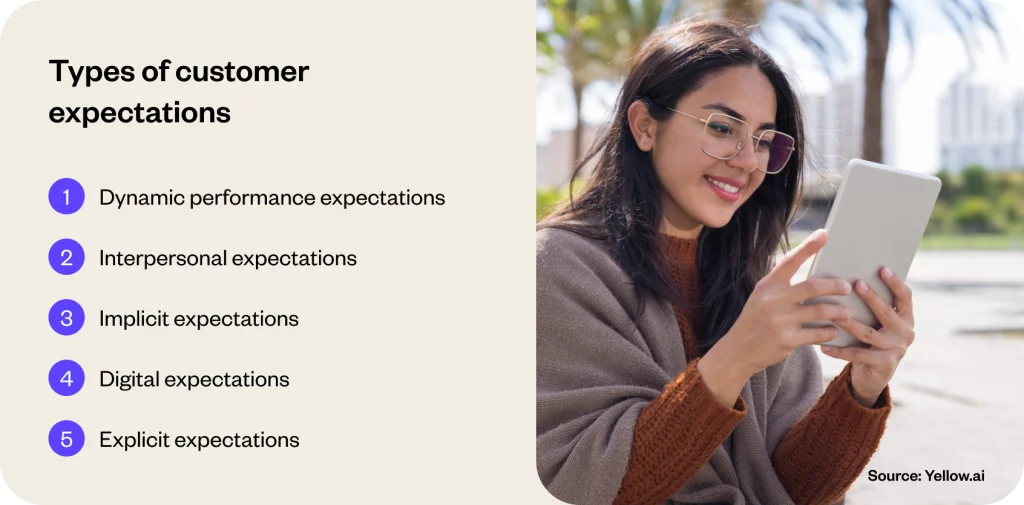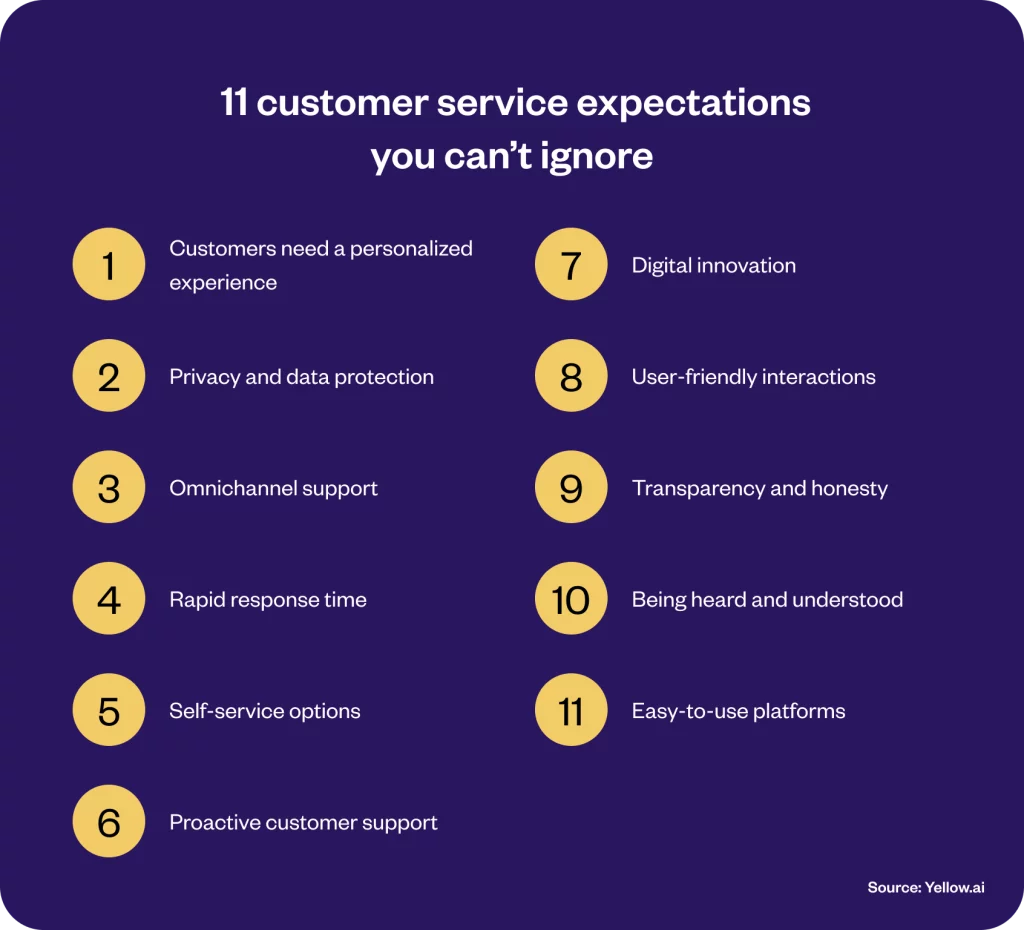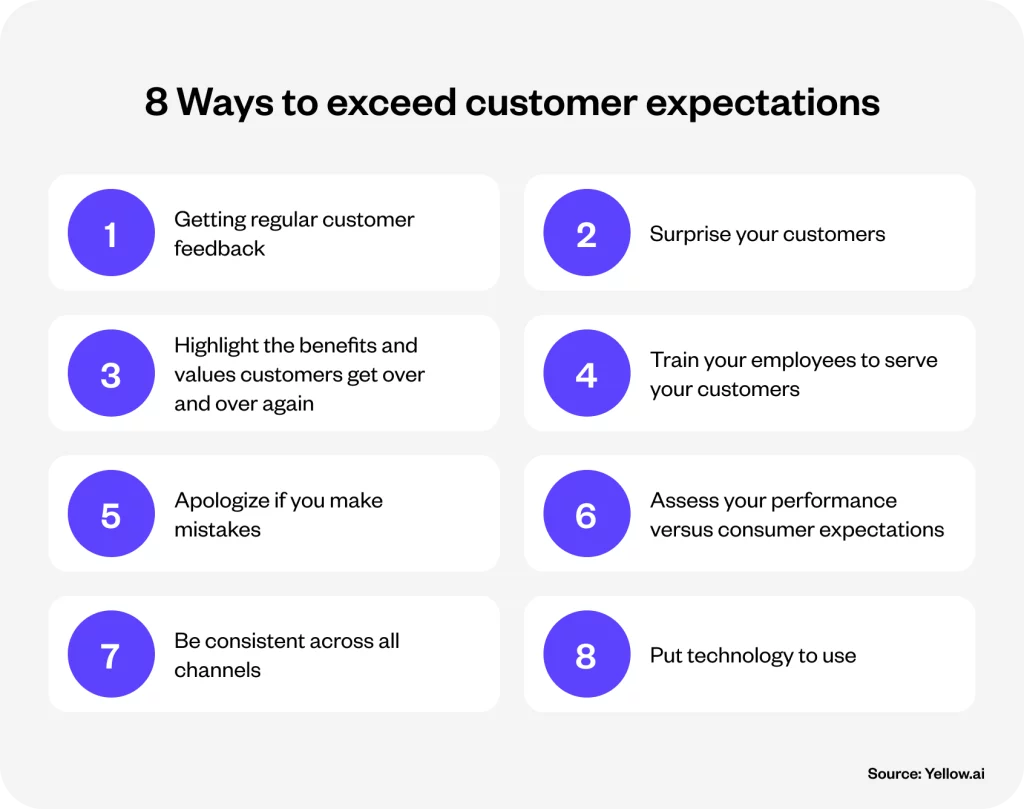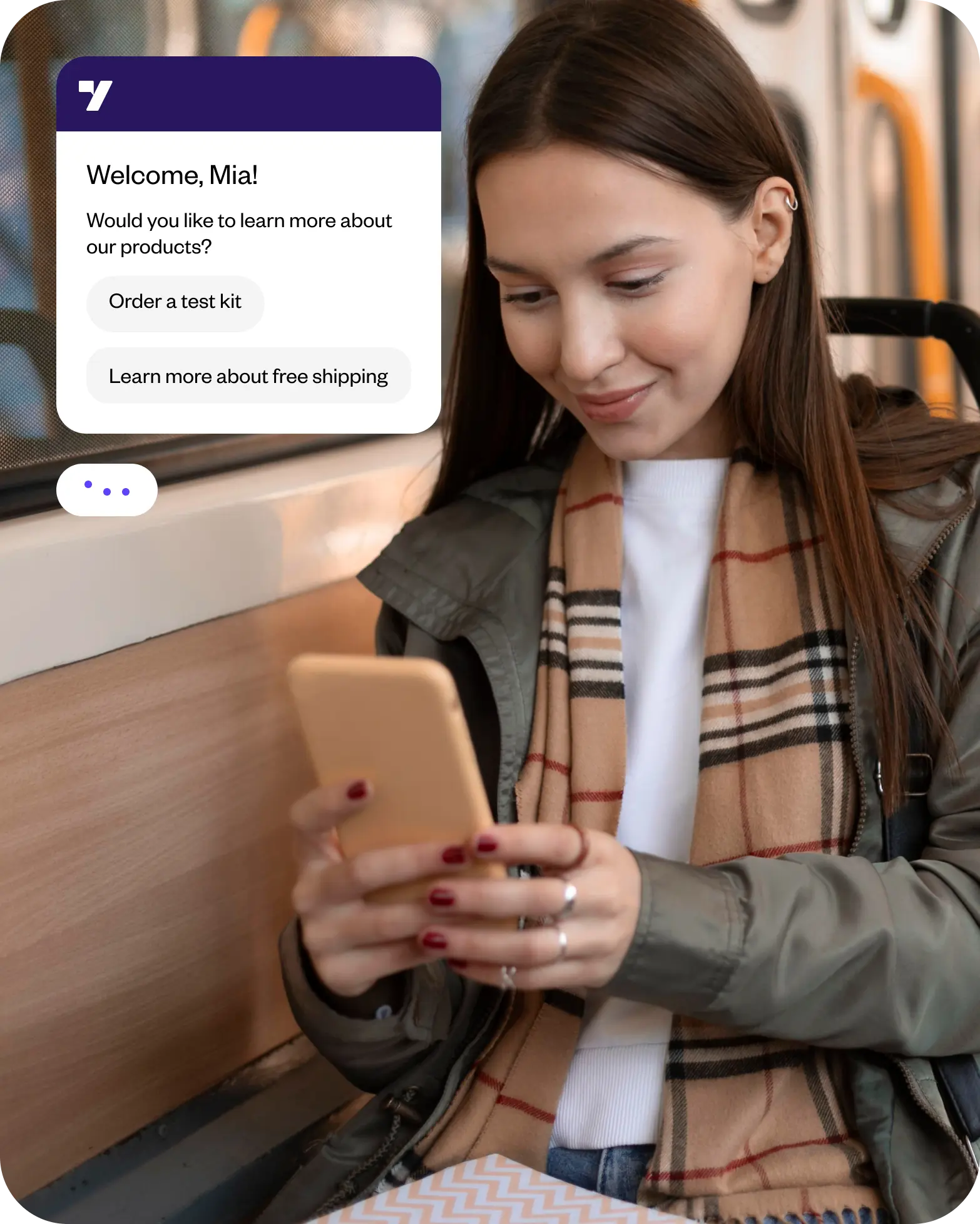Summary:
Customer expectations are activities, interactions or behaviors people expect from a business. From anticipating just good service and fair pricing, there is a shift in customer nature and mindset. Modern consumers want proactive service, individualized interactions, and integrated digital experiences. According to Salesforce Research, of 14,300 consumers and corporate buyers globally, 80% of customers appreciate a company’s experience as highly as its products and services. This blog explains the definition, importance, methodologies, non-negotiable consumer expectations, and ways to surpass them.
What are customer expectations?
A few top customer expectations are making them feel heard and valued, providing an easy, friction-free process, extending multiple channels for customer support, taking prompt and quick action for requests or troubleshooting, assuring personalized, empathetic and proactive customer service and giving self-service options. Thus, they include a gamut of demands that a customer expects today. One also must discern that customer service expectations also differ for different age groups or generations. These are evolving dynamics, and businesses that understand, capture and embrace them are better positioned to meet and exceed customer expectations. It leads to forging lasting relationships between the businesses and their end-users. According to a survey with multiple options, out of 300 participants, 58% of customers ranked ‘being heard, seen, valued, appreciated and understood’ as the most important expectation from businesses. These parameters drive customers to engage, spend and stay loyal to a brand.
Why understanding customer expectations is crucial for success?
Understanding and meeting customer service expectations are crucial for success and long-term sustainability of your brand. As customer expectations evolve and become more demanding, failing to meet them can have adverse consequences. Research indicates that only 3% of customers consider customer service unimportant in purchasing decisions, and a staggering 92% would cease buying from a company after three subpar experiences.
Meeting and exceeding customer expectations directly influences a business’s success. With abundant choices available to consumers, businesses must rapidly recognize and adapt to evolving expectations. Fulfilling these demands and hopes differentiates a brand from its competitors and strengthens customer relationships. Higher customer satisfaction contributes to increased loyalty, more referrals, and a positive word-of-mouth reputation, attracting new customers.
Failure to understand and cater to customer expectations can be detrimental. Scenarios, where customers receive products of poor quality, poor value at a high price, delayed deliveries, or inefficient customer service, contribute to dissatisfaction and negatively impact customer retention.
For example: You are a seller of organic cosmetics, and you score high in quality, price and purity. These factors fetch you customers. But you lag in customer service. This is when your competitor with a solid system in place meets customer service expectations even with products which price much higher, it takes away your customers.
This results in a loss of sales and necessitates increased investment in acquiring new customers through advertising and marketing efforts. Its significance becomes even more apparent considering the substantial impact on revenue. Studies show that satisfied customers will likely spend 140% more after a positive experience. Thus, closing the gap between customer expectations and customer experience is critical for companies to succeed and thrive.
Types of customer expectations
There are several types of customer expectations. You need to identify your business’ strengths and weaknesses in exceeding or failing to meet them in each of these variants. After your SWOT analysis, you can focus on the type of customer expectations your patrons demand from you. Here, we outline the top five types that can either seal the deal or result in the loss of a customer forever.

Type 1: Dynamic performance expectations
Customers anticipate ongoing improvements in your products or services, known as “dynamic performance expectations.” These expectations hinge on market shifts and competitors’ advancements. Staying responsive to evolving market trends ensures your offerings remain competitive and aligned with customer expectations.
Type 2: Interpersonal expectations
Interpersonal customer expectations involve how consumers anticipate interaction with your CS team. Expectations around in-store, live chat, and customer support calls include response times, customer service quality, and your brand’s reputation for offering good customer service. To gain confidence and loyalty, match these expectations.
Type 3: Implicit expectations
Implicit customer expectations are customers’ basic assumptions about your product, service, or company, even if not explicitly defined. Customers typically base their expectations on family and friend recommendations, internet ratings, and prior experiences with comparable firms. Satisfying these implicit expectations improves consumer satisfaction.
Type 4: Digital expectations
Digital expectations include customers’ online interactions with your business via websites, mobile applications, and social media. Ensuring these channels are user-friendly, informative, and efficient is crucial. A cafe’s digital expectations include easy navigation, a visible menu, and a rapid reservation procedure, optimizing the online customer experience.
Type 5: Explicit expectations
Customers have certain, non-negotiable “musts” in mind while making a purchasing decision; these are known as explicit expectations. A few examples of them include cost, quality, and turnaround time. A mobile phone buyer expects certain specs within a certain price range. Satisfying customers requires meeting these expectations.
11 Customer service expectations you can’t ignore
There are a few key points to meet the expectations of today’s aware customers. The list includes:

Customers need a personalized experience
Customers are no longer satisfied with one-size-fits-all solutions. The need for personalized interactions is unavoidable and businesses must tailor their approach to each customer, offering a unique and meaningful experience.
What is personalized customer service experience?
Customers prefer you to remember your name, age, likes and dislikes. According to a Personalization Report conducted by Segment, 71% of customers get frustrated by feeling impersonal with a brand.
Related read: How to improve customer service experience?
Do’s
To master personalization at every touchpoint, pay close attention to what the customer wants and needs. Likewise, take close note of what and how they are expressing and, request their preferences and interests and provide customized solutions. You need to address them by name if you want them to feel valued.
Don’ts
Avoid judging them by their demographics or other statistics. Instead of guessing, know the customer persona using market research.
Privacy and data protection
Big companies make headlines almost every month due to data breaches and exposed information. A greater amount of personal and company data has been made public than in previous decades due to the trend toward digitalization.
What is privacy and data protection in customer service?
In customer service privacy and data protection are non-negotiable. Data privacy deals with the question of who may access what data, whereas data protection asks how to limit that access through regulations and techniques. It means an assurance by you to your customers that their sensitive information is safe and guarded. For this, you need to keep updating and upgrading your systems aligning with safety protocols.
Do’s
Businesses should manage personal data securely, be upfront about data acquisition, and offer privacy control alternatives when customers consent. Executing that will increase consumer trust and loyalty.
Don’ts
Cybercriminals can get into any obsolete or poorly protected system with a few scripts and keystrokes, putting many people’s data in danger. Vulnerable systems risk data breaches, disclosing customer information and shattering trust. Don’t collect more data than needed, nor share customer info without consent. Never leave data exposed or unsecured. Don’t ignore customer requests to access or delete their data.
Omnichannel support
Customers expect the flexibility to engage through their preferred channels, with preferences varying across generations and issues. As expectations rise, adapting to omnichannel support becomes essential, as well as streamlining processes and meeting the dynamic demands of modern customer service.
Related read: Seamless omnichannel CX: Your step-by-step guide
What is omnichannel support?
To meet your customer service expectations, you must cater to diverse needs. Provide them with multiple communication avenues or ways to connect and interact with your brand, such as live chat, email, social media, phone, SMS, and in-person services.
Do’s
Try to handle the real challenge which lies in seamlessly connecting these channels to create a continuous conversation. Bridging this gap requires integrating customer service technology into a unified platform, fostering collaboration among agents and departments. This approach ensures a smooth channel transition, enhancing the overall customer experience.
Don’ts
Don’t silo your channels! Customers expect a seamless flow, so make sure info follows them. Never make them repeat their story – integrate your systems! Ditch the robot responses across channels, instead, adopt personalized responses, especially for complex and sensitive issues. Don’t offer a million options – a clear, easy-to-navigate system keeps everyone happy.
Rapid response time
Customers demand rapid responses, expecting quick issue resolution, whether on digital channels or third-party review sites. According to Statista, monitoring platforms like review sites is crucial, with 53% expecting a response to negative reviews within a week. In the realm of social media, swift responses are imperative; 18% anticipate a reply within an hour. Public-facing information can shape perceptions rapidly. Speed is paramount for an optimal online experience—94% of consumers value it highly. Resolving issues in a single interaction is equally vital.
What is rapid response time?
Rapid response time co-relates to customer service response time—the time it takes your support team to answer a customer’s query. It is the gold standard for measuring successful customer service. However, itt is conditional upon the customer service channels. A good response time for email is 12 hours or less, whereas 4 hours or less is better. Responding within 5 hours or less is good on social media. Doing it within 2 hours or less is better. Responding within less than 40 seconds is better in live chat.
Do’s
There are certain benchmarks which you must follow in modern customer service dynamics. Employing technologies like live chat and actively addressing complaints across all channels ensures efficient resolutions. Equipping agents with knowledge and resources further contributes to quick and accurate customer responses, which is crucial in today’s fast-paced digital landscape.
Don’ts
Don’t sacrifice quality for rapid response. A lightning-fast bot response that misses the mark leaves customers frustrated. Never ignore that a helpful first response beats a lightning-fast, useless one any day. Don’t forget customers appreciate genuine care, not just instant messages.
Self-service options
According to a survey, customers increasingly prefer self-service options, with 90% expecting online portals, like chatbots and help centers. Studies by Zendesk reveal that 69% attempt self-resolution before contacting support, emphasizing the need for accurate self-service knowledge bases. A company’s website should incorporate a self-service application, as 70% of customers expect it, according to Steven Van Belleghem’s research. Another report highlights that 73% want the ability to solve their problems independently.
Related read: Self customer service: Navigating the new era of empowered consumers
What does self-service option mean?
Self-service options are customer empowerment tools, not replacements for human care. Think clear FAQs, helpful knowledge bases, and intuitive chatbots that answer basic questions.
Do’s
To meet the customers’ expectations in this space, curate FAQ pages, update them regularly, and ensure accuracy in self-service portals. Empowering customers with effective self-help tools aligns with evolving preferences and enhances the overall customer experience. Ask relevant questions in Customer Satisfaction Survey to understand your patrons expectations.
Don’ts
Don’t leave them stranded in a self-service maze. Offer clear, concise instructions and make sure your knowledge base is top-notch. Never forget that self-service should streamline, not sideline. Think user-friendly search functions, not knowledge labyrinths. Self-service shouldn’t replace the human touch. Offer easy ways to connect with live agents for complex issues.
Proactive customer support
For effective customer service, proactively engaging customers is a best practice. Businesses that anticipate concerns before customers inquire demonstrate proactive customer service. Responding promptly across communication channels, including SMS, email, phone, and in-person interactions, is crucial. Begin responses with apologies, context, and reassurance, ideally within a few hours. According to a study by Microsoft named ‘State of Global Customer Service’, leveraging available customer data is vital, as 70% of customers view brands more positively with proactive service notifications.
Related read: Proactive customer service: Definition, benefits, and examples
What is proactive customer support?
Proactive support is like anticipating a customer’s needs before they even ask. For example, use purchase history to suggest helpful articles or offer live chat pop-ups during peak inquiry times. Don’t simply solve problems—show customers you care about their experience.
Do’s
Implement proactive support using live chat or chatbots triggered by customer behavior. Keep content updated, actively solicit feedback through surveys, and address recurring issues before they escalate.
Don’ts
Don’t become a fortune teller! Anticipate customer needs, but avoid overwhelming them with unsolicited info. Use data smartly to offer relevant solutions, not generic blasts. Remember, being proactive means being helpful, not intrusive. Customers appreciate a heads-up, not a feeling of being micromanaged.
Digital innovation
Embracing digital innovation is pivotal for meeting rising customer expectations. Over 60% of consumers credit retail technologies for enhancing their shopping experiences. To stay competitive, businesses must integrate emerging tech like AI chatbots, VR, AR, and video into customer service processes—72% expect increased virtual assistance, and 68% anticipate immersive virtual or augmented reality experiences. Customers now demand an omnichannel presence across the web, social media, phone, email, and text. Leveraging text messaging is crucial, as it’s the most frequently checked and responded to channel, especially among younger customers. An omnichannel strategy fosters brand awareness and builds customer loyalty, aligning with the evolving communication preferences of 64% of consumers who prefer talking to customer service via familiar channels.
Do’s
Chatbots can answer FAQs, freeing you from complex issues. AI can analyze trends, helping you predict customer needs. Use digital tools to personalize support and offer relevant solutions.
Don’ts
Customers crave genuine care, not just cutting-edge features. AI chatbots and voice agents are cool, but they should be trained to be empathetic, not robotic. Fancy dashboards are great but ensure intuitive interfaces for both reps and customers. Remember, the latest tech should enhance, not replace, the human connection.
User-friendly interactions
Simplifying interactions is imperative. Ensure your website and mobile experiences are streamlined, offering clear instructions, prominent calls to action, and accessible support options. Prioritizing user-friendly interactions meets customers’ preferences and improves overall engagement and satisfaction. Creating a memorable experience for your customers involves prioritizing user-friendly interactions.
Do’s
Factors such as up-to-date inventory, easy navigation, and a user-friendly design contribute significantly. Among consumers, 15% prioritize up-to-date inventory, while 13% value easy navigation and 12% appreciate a user-friendly design. Keep information current, optimize website user experience, and address common customer questions.
Don’ts
User-friendly means easy to navigate, not dumbed down, nor a one-size-fits-all approach. Never shy away from tailor your approach to each customer’s needs! Keep language clear and simple. Avoid robotic scripts and jargon-filled legalese. Empower customers, don’t frustrate them!
Transparency and honesty
Customer service expectations are driven by transparency, which in turn leads to higher engagement. No one likes to be in a gray area. Keep things black and white. A survey found that 62% of consumers had cut ties with a business whose principles they felt did not share their own. Delivering on the promises your solutions promote and engaging in honest and transparent communication regarding a product or service are all part of this.
Do’s
If an issue arises, it is essential to express regret, take full responsibility. Inform clients about the expected timeline and follow-up as they wait for a resolution.
Don’ts
Never sugarcoat the truth -be honest, but empathetic. Transparency builds trust, but don’t confuse it with TMI (too much information). Set realistic expectations upfront and avoid overpromising. Customers appreciate genuine care, not a perfect facade.
Being heard and understood
Revolutionize customer interactions by shattering the norm! A mere 38% of U.S. consumers feel their needs understood; a paltry 46% echo this sentiment worldwide. In a transactional world, it transcends commerce. When they entrust money, it’s not just for service—it’s a vote of confidence. When they reach out, it’s personal—they yearn to be heard and valued.
Do’s
Reshape the narrative; mere issue resolution pales against the power of acknowledgement. Fuse transactional touchpoints with transformative dialogues; elevate interactions beyond the mundane. Let customers vent (within reason!), then actively paraphrase to show understanding. Allow the winds of change to blow through, making “being heard and understood” not a tagline but a revolutionary manifesto!
Don’ts
Never mistake listening for assuming; instead, actively listen. Ask clarifying questions, and avoid an interrogating tone. Don’t jump to conclusions or offer generic scripts. Feeling heard isn’t just about silence; it’s about acknowledging their emotions with genuine empathy.
Easy-to-use platforms
Customers expect seamless experiences on easy-to-use platforms. Each roadblock encountered in the customer journey adds distress and potential abandonment. Providing alternative products doesn’t guarantee loyalty; the ease of the journey matters. Complexity is a detractor, with 40% preferring real-person conversations for intricate matters like payment disputes.
Do’s
Simplify communication platforms to make customers feel smart, allowing them to achieve goals without stress effortlessly. Ensure a smooth journey, pinpoint pain points, and embrace customer journey mapping for continuous improvement. Prioritize user-friendly platforms not just to meet but exceed customer expectations.
Don’ts
Avoid hidden menus that leave customers feeling lost; opt for intuitive layouts instead. Also, avoid overwhelming them with features. Your platform should be responsive and optimized for mobile devices, as over half of client interactions occur on them. FAQs, knowledge bases, and contact info should never be buried.
8 Ways to exceed customer expectations
There are several ways you can exceed customer expectations effortlessly. All you need to do is identify the areas your CS and CE are lacking and address them proactively. Here are eight ways to outdo what your customers expect from you.

Getting regular customer feedback
Gather continuous customer feedback to stay attuned to their evolving preferences and needs, ensuring proactive adjustments for an enhanced experience. This way you can exceed customer expectations.
Surprise your customers
Who doesn’t like surprises and gifts? Delight your customers with unexpected gestures or benefits, fostering positive emotions and exceeding their initial service expectations for a lasting impression.
For example: You are a B2B marketing agency and serve a corporate customer. To surprise and satisfy the customer, give a free in-depth study of their marketing strategies and customized ideas for improvement. This extra service shows your commitment to their achievement.
Highlight the benefits and values customers get over and over again
Customers come to you with questions or problems they need to solve. Your job is not just to fix those issues but to wow them. How? By highlighting your company’s superpowers (those are your USPs) in a helpful, non-sales way. By prioritizing solutions over sales pitches, trust is built. You meet your customers expectations with ease. They view you as a valuable partner who isn’t bragging about its fancy features or trying to make a buck. You’re conveying to customers how those features can make their lives easier. They will remember your brand and pick you for exceptional service as you consistently remind them of the value you provide.
For example: A customer bought a new fitness tracker from your brand and is set to embark on his health journey. But then, he gets stuck on how to connect it to his phone. That’s where customer service pitches in! During such an interaction, instead of saying “fast resolution times,” you could say, “We offer 24/7 live chat support for you to get back to your workout in no time!”
Train your employees to serve your customers
Equip and arm your team with excellent customer service skills, ensuring they understand customer needs and can exceed expectations through knowledgeable and attentive interactions.
Apologize if you make mistakes
Acknowledge mistakes promptly, apologize sincerely, and take swift corrective actions to rebuild trust and demonstrate commitment to customer satisfaction.
Assess your performance versus consumer expectations
Repeating the same thing and expecting different results is absurd. Improvement requires change. Learn about your service experience and how to improve it by measuring the correct metrics. These indicators allow us to track our progress.
Be consistent across all channels
Provide a seamless and consistent experience across all customer touchpoints, ensuring a cohesive and positive interaction, whether online, on the phone, or in person. Pay equal attention to every channel. Shocking yet true, industry surveys show that 62% of businesses ignore client service emails. A 12-hour response time is typical, which lowers customer satisfaction. In this scenario Email automation has been proving a game changer.
Yellow.ai Email Automation, powered by YellowG, its proprietary LLM, can understand unstructured emails, precisely recognize numerous intents, infer the email’s object and urgency, and provide 24/7 response. It identifies the user and provides a relevant response based on user insights, reducing ticket volumes by 80% and improving first-contact resolution by 20%.”
Raghu Ravinutala, CEO & Co-Founder, Yellow.ai.
Watch this video to learn more about Yellow.ai Email automation!
Put technology to use
Exceeding customer expectations is easier with the correct tools. Automate customer support with chatbots, knowledge bases, and other self-service capabilities. Tailor your customer experience with data and analytics; organize inbound queries across channels with an all-in-one customer care platform.
How does Yellow.ai help with automating customer support?
Yellow.ai has positioned itself as the leader in the world in automating customer support. According to an Economic Times report, Yellow.ai deployed 120 GenAI for organizations globally this fiscal year, and over 30% of those bots were deployed in India. GenAI mainly automates customer service to cut costs in regions like the US. There are also several tech-based tools, services, platforms and solutions for businesses with an online presence across the sectors to automate customer support. Here are a few of the effective ways Yellow.ai helps with automating customer support:
Automate monotonous tasks
By partnering with Yellow.ai, you can automate repetitive and tedious customer support tasks effectively. This will take the burden off the human CS team. Using our dynamic automation platform (DAP), you can enhance and automate customer support and increase efficacy in meeting customer service expectations.
Harness the power of Inbox
Yellow.ai’s Inbox is a generative AI-powered helpdesk that can equip your support team with the necessary resources. Both productivity and cost savings are guaranteed as it expertly manages customer interactions across various communication channels.
Linguistic command for global audience
Customers from different regions and countries often feel more comfortable conversing in their native language. With our Yellow.ai DynamicNLP, even if your business is in the US, you can communicate to a global audience in their language. DynamicNLP is the first-of-its-kind in the business conversational AI space, eliminating NLP training, and it is an expert in 135+ languages.
Ready to lead in customer service in Indonesia with Komodo-7B?

AI-powered automation
Advanced AI chatbots and voice agents are Yellow.ai’s main feature. These deep-learning chatbots comprehend client intent and deliver relevant replies to inquiries. Our AI voice agents can serve multilingual consumers. Businesses may save client wait times by using a virtual assistant to address various consumer inquiries 24/7.
YellowG the powerhouse with multiple perks
Our state-of-the-art multi-LLM Generative AI technology, YellowG, allows for goal-oriented conversations that come across as human. YellowG’s dynamic workflow automation may boost agent productivity, streamline operations, and save CX and other costs.
Automating customer support effectively

Customer expectations – Key takeaways
Meeting and exceeding customers’ expectations is essential if you want their contentment. You gain their confidence when you consistently satisfy their expectations. Even as consumer expectations rise, staying ahead of their needs may help you personalize your offerings and provide a better experience overall. Customer feedback software, constant product improvement, and open communication help build long-term customer connections. Listening to your consumers allows you to exceed their expectations, position yourself as an industry leader, expand, and build a reputation for excellence. Expectations from customers, already high, will only go up in the years to come. If you keep cognizant of these expectations, you can fulfill them and provide outstanding customer service that adds value. You may improve your ability to satisfy your customers’ expectations by applying the recommendations in this blog. This will encourage your pleased customers to return for future purchases and grow customer loyalty.
Frequently asked questions (FAQs)
What are the key expectations customers have from a service?
Customers’ key expectations from a service are primarily around speed, convenience, accuracy and empathy from your service team while responding to their questions. Most expect customer service representatives to reply and resolve successfully in less than four hours.
What is the impact of not meeting customer service expectations?
The impact of failing or not meeting customer service expectations can divert your customers to your competitors, who they feel would satisfy them. This is out of their immense dismay, frustration, and grievance. You will lose your customers, business, credibility and reputation.
How can businesses measure customer service satisfaction?
Businesses can measure customer service satisfaction using methods such as Net Promoter Score (NPS), consumer surveys, online customer reviews, and their feedback and complaints. Repeat business is another parameter. The most commonly employed measurement is the Customer Satisfaction Score (CSAT).
What role does personalization play in customer service?
Personalization plays a crucial role in customer service. It means a tailored approach to meet each customer’s individualized needs. It proves to customers that the business listens, values, understands, and can meet their needs, building trust.
How can technology improve customer service?
Technology has been a catalyst for improving customer service. Businesses embracing and integrating various forms of technology into their system deliver better customer service. From AI-powered chatbots, voice agents, and virtual reality, analytics technology is resulting in improved interaction, personalized services, 24/7 automated service, cost reduction, increased efficiency of human agents, etc.














